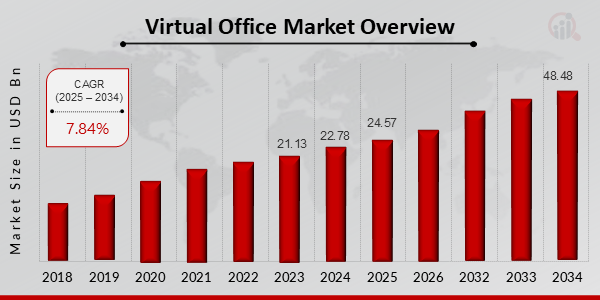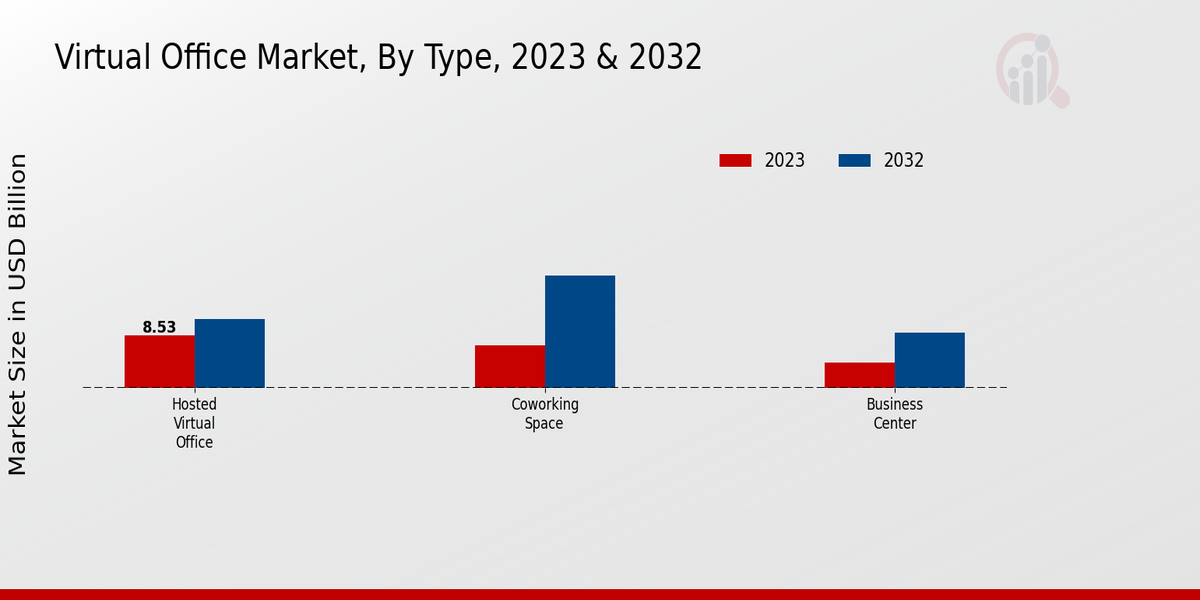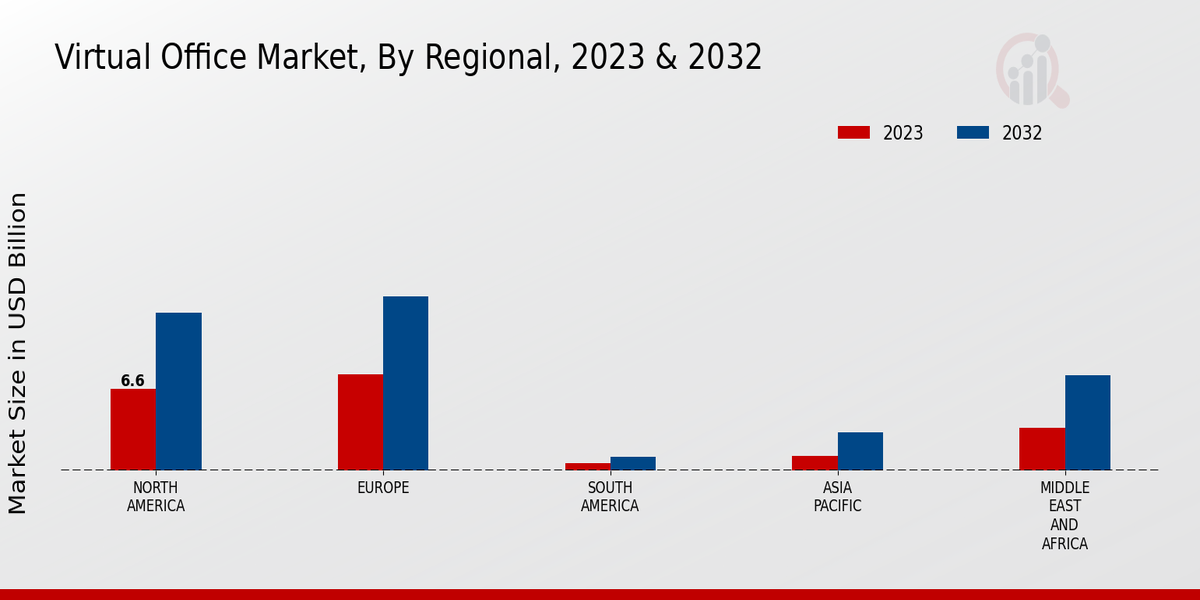Virtual Office Market Overview
Virtual Office Market is projected to grow from USD 24.57 Billion in 2025 to USD 48.48 Billion by 2034, exhibiting a compound annual growth rate (CAGR) of 7.84% during the forecast period (2025 - 2034).
Additionally, the market size for Virtual Office Market was valued at USD 22.78 billion in 2024.
Key Virtual Office Market Trends Highlighted
Key market drivers include the rising adoption of remote work models, cost-effectiveness compared to traditional offices, and increased flexibility for businesses. Opportunities lie in the expansion of shared virtual workspaces, integration with advanced technologies like virtual reality and augmented reality, and the crescent need for virtual support services.Recent trends indicate a shift towards more comprehensive virtual office solutions that offer a range of services, such as virtual mailboxes, video conferencing, and online collaboration tools. The market is also witnessing the emergence of customized virtual office solutions tailored to specific industry requirements.
As businesses continue to embrace hybrid and remote work models, the demand for virtual office solutions is expected to grow significantly.
Figure 1: Virtual Office Market Size, 2025-2034 (USD Billion)

Source: Primary Research, Secondary Research, Market Research Future Database and Analyst Review
Virtual Office Market Drivers
Greater Flexibility and Scalability
The virtual office market is experiencing significant growth due to the increasing demand for flexible and scalable workspaces. Virtual offices offer businesses the ability to operate from anywhere in the world without the need for physical office space. This flexibility is particularly appealing to small businesses and startups, which may not have the resources to invest in a traditional office space. Additionally, virtual offices can be easily scaled up or down, as needed, making them ideal for businesses that are experiencing rapid growth or change.
The growing popularity of remote work and the increasing adoption of cloud-based technologies are also contributing to the growth of the virtual office market. Virtual offices provide businesses with a range of benefits, including Reduced costs: Virtual offices are typically more affordable than traditional office spaces, as they do not require the same level of overhead costs (e.g., rent, utilities, furniture).
Increased productivity: Virtual offices can help to improve productivity by providing employees with a quiet and distraction-free work environment.Improved employee morale: Virtual offices can help to improve employee morale by providing employees with the flexibility and autonomy to work from anywhere they choose. Enhanced collaboration: Virtual offices can help to enhance collaboration by providing employees with access to the same tools and resources, regardless of their location. Increased customer satisfaction: Virtual offices can help to improve customer satisfaction by providing businesses with the ability to offer 24/7 support.
Cost Savings
One of the benefits of virtual offices for businesses is that they offer considerable cost savings. Indeed, these types of offices do not require significant overhead costs, including rent, utilities, or the purchase of furniture. For smaller companies, especially startups, the abovementioned feature allows for reducing costs significantly and avoiding financial instability through savings. In general, virtual offices allow businesses to keep their operating costs down by providing resource sharing, such as the use of specific equipment and meeting rooms.
Access to a Global Talent Pool
One of the benefits of virtual offices is that they allow companies to engage with the global skills and competence of a workforce. Virtual offices enable companies to employ staff irrespective of their location in the whole world. This is important as it allows companies to hire the best person who matches their job descriptions and who best meets their human resource requirements at any particular time.
The virtual office, in this case, helps expand human resource capacity.The virtual office is, in this case, therefore, paramount as it allows its users to broaden their access to the best human resources and, at the same time, reduce the cost of recruitment by increasing the number of existing potential employees.
Virtual Office Market Segment Insights
Virtual Office Market Type Insights
The segmentation of the Virtual Office Market by Type includes Hosted Virtual Office, Coworking Space, and Business Center. Among these categories, the Hosted Virtual Office division occupied the biggest market share in 2023 and is likely to retain this position during the forecast period. This segment is also expected to grow the fastest. By 2032, the Hosted Virtual Office submarket is likely to be evaluated at 12.46 Billion USD, increasing at a CAGR of 7.4%.
The demand is largely caused by the popularity and adoption of remote work and the provision of flexible and economical offices.This type of virtual office grants a business a virtual address, phone answering services, mail handling, and other administrative backing without the necessity of an actual location. The Coworking Space submarket is anticipated to continue increasing steadily, being valued at 10.1 Billion USD by 2032 at a CAGR of 8.2%.
The popularization of remote work and the variety and affordability of office space of this type remain the main reasons for growth. Coworking spaces are shared work environments offering amenities to professionals, startups, freelancers, and small businesses.Finally, the Business Center subdivision, which is expected to remain the smallest but retaining stable growth, may reach a value of 6.08 Billion USD by 2032, increasing at a CAGR of 7.1%. Such offices provide a serviced space with furniture, high technology, and business support for small and mid-size companies.

Source: Primary Research, Secondary Research, Market Research Future Database and Analyst Review
Virtual Office Market Deployment Type Insights
Virtual Office Market, By Deployment Type Based on deployment type, the Virtual Office Market can be segmented as cloud-based and on-premises. In the cloud-based deployment type, the application of virtual office services is provided to the users through the internet. In comparison, the on-premises deployment type requires the installation and maintenance of the virtual office software and hardware at the customer’s facility by the provider. The cloud-based segment is the largest and most rapidly growing segment in the Virtual Office Market.
This is as it is beneficial to the end-user in terms of cost-effectiveness and other advantages like scalability and flexibility.The cloud-based segment is expected to grow at a CAGR of 8.2% by the end of the forecast period and capture a market share of USD 22.58 billion by the end of 2026.
The on-premises segment is forecasted to grow at a slower rate and account for a market share of USD 16.06 billion by the year 2026. This is because of the significant up-front investment and high, ongoing maintenance cost involved in on-premises deployment. At the same time, the on-premises segment would still be preferred and not totally abandoned because many enterprises look to enhance the degree of control over their virtual office systems, hence the need for customization.
Virtual Office Market Business Size Insights
The Virtual Office Market is segmented by Business Size, such as Small and Medium-Sized Enterprises (SMEs) and Large Enterprises. The SME segment is expected to account for a larger market share during the forecast period, owing to the increasing adoption of virtual offices by SMEs to reduce costs, increase flexibility, and enhance productivity. The Large Enterprise segment is also expected to witness significant growth as large enterprises seek to optimize their operations and reduce real estate costs.
The Virtual Office Market revenue for the SME segment is projected to reach USD 14.2 billion by 2024, growing at a CAGR of 8.2%.The Large Enterprise segment is expected to reach USD 11.4 billion by 2024, growing at a CAGR of 7.6%.
Virtual Office Market Industry Vertical Insights
The Virtual Office Market segmentation by Industry Vertical is categorized into Finance and Banking, Information Technology (IT), Healthcare, Education, and Legal. Among these segments, the Information Technology (IT) industry held the largest market share in 2023, accounting for around 28.5% of the Virtual Office Market revenue. The IT industry's high demand for virtual offices is attributed to the increasing adoption of remote work and the need for flexible and cost-effective workspaces.
The Finance and Banking sector is expected to witness significant growth over the forecast period, owing to the rising demand for virtual offices by financial institutions to streamline operations and enhance collaboration among remote teams.The Healthcare industry is also projected to contribute to the growth of the Virtual Office Market, driven by the increasing adoption of telemedicine and the need for virtual spaces for patient consultations and remote care. The Education sector is expected to witness a steady growth rate as virtual offices offer a convenient and flexible learning environment for students and educators.
The Legal industry is anticipated to have a moderate growth rate, as virtual offices provide a professional and secure workspace for legal professionals to collaborate and manage their cases remotely.
Virtual Office Market Value-Added Services Insights
Value-Added Services The value-added services segment is expected to witness significant growth in the Virtual Office Market over the forecast period. This growth can be attributed to the increasing demand for professional and cost-effective business solutions by enterprises of all sizes. Value-added services such as phone answering, mail handling, meeting rooms, event space, and technical support play a crucial role in enhancing the efficiency and productivity of businesses.
Phone answering services provide businesses with a professional and dedicated receptionist to handle incoming calls, ensuring that no important calls are missed.Mail handling services offer a secure and convenient way for businesses to receive and manage their mail, eliminating the need for physical office space.
Meeting rooms and event spaces provide businesses with flexible and affordable options for hosting meetings, presentations, and other events without the need for long-term leases or capital investments. Technical support services offer businesses access to expert assistance for resolving technical issues, ensuring smooth operations, and minimizing downtime. The phone answering services segment is expected to account for a significant share of the Virtual Office Market revenue in 2023, with a projected valuation of USD 4.6 billion.The mail handling segment is also expected to witness substantial growth, with a projected valuation of USD 2.5 billion in 2023.
The meeting rooms and event space segment is anticipated to grow at a CAGR of 6.8% during the forecast period, reaching a valuation of USD 3.2 billion by 2032. The technical support segment is expected to contribute significantly to the market growth, with a projected valuation of USD 2.8 billion in 2032.
Virtual Office Market Regional Insights
The regional segment of the Virtual Office Market holds significant importance in shaping the industry landscape. North America dominates the market with a substantial revenue share, driven by the presence of numerous established players and a high adoption rate of virtual office solutions among businesses of all sizes. Europe follows closely, with a growing demand for flexible workspace options and collaboration tools.
The APAC region is projected to witness the highest growth rate in the coming years, owing to the rising number of startups and SMEs seeking cost-effective business solutions.South America and MEA also contribute to the global market, with increasing demand for virtual office services in major cities such as So Paulo, Rio de Janeiro, and Dubai. These regional insights provide valuable information for businesses seeking to expand their operations or target specific markets within the Virtual Office Market.

Source: Primary Research, Secondary Research, Market Research Future Database and Analyst Review
Virtual Office Market Key Players and Competitive Insights
The key players in the Virtual Office Market are continually trying to enhance offerings and consolidate their market presence by expanding to developing countries. The leading players in the market are heavily investing in research and development to introduce new solutions according to the needs and demands of end-users. The trends in Virtual Office Market development are shaping the industry as shifting toward more comprehensive solutions. One such trend in this framework is the escalating incidence of cooperation and partnership strategies emerging in the market. Virtual Office Market Competitive Landscape is set to remain highly competitive in the coming years.
The existence of new entrants tends to make the Virtual Office Market more competitive than ever before.Regus is one of the leading providers of flexible workspaces and offers a wide range of virtual office services tailored to the needs of companies of all sizes. The company operates a network in over 3,000 locations worldwide and has a presence in 120 countries. Many major enterprises and Fortune clients rely on Regus services, and the Regus network offers a uniform and professional appearance around the world.
Regus offers a range of customizable membership plans and a variety of services for companies of all sizes. One of the upsides for this specific potential provider is the added value services offered, such as meeting rooms, video conferencing, and other administrative support activities.
The strong focus of Regus on innovation and the satisfaction of its customers makes Regus one of today’s most favored virtual workspace suppliers.Another major player in the market is IWG, the global provider of solutions for flexible workspaces. IWG operates a uniform network in over 3,000 locations in over 120 countries and offers virtual office services to companies of all sizes. Regus, Spaces, Signature by Regus, and Open Office are among the brands within the IWG Group, each catering to a separate market with its four brands.
IWG’s significant commitment to innovation is allowing the provider to offer market players a number of advanced solutions. For example, about their meeting room, handling accounts and exposure to all the other members, the company’s IWG App. IWG is popular among clients who have developed a strong commitment to corporate responsibility.
Key Companies in the Virtual Office Market Include
Virtual Office Market Industry Developments
The Virtual Office Market is projected to reach USD 38.64 billion by 2032, exhibiting a CAGR of 7.84% from 2024 to 2032. This growth can be attributed to rising demand for flexible workspaces, cost-effectiveness, and technological advancements. The increasing adoption of remote work has led to a surge in demand for virtual offices as businesses seek to reduce overhead costs and enhance employee productivity. Moreover, advancements in video conferencing and cloud-based collaboration tools have made virtual offices more accessible and efficient.
Key market players are focusing on expanding their global presence and offering customized solutions to meet the diverse needs of businesses. Strategic partnerships and acquisitions are also shaping the competitive landscape, with companies seeking to enhance their service offerings and gain market share.
Virtual Office Market Segmentation Insights
-
Virtual Office Market Type Outlook
-
Virtual Office Market Deployment Type Outlook
-
Virtual Office Market Business Size Outlook
- Small and Medium-Sized Enterprises (SMEs)
-
Virtual Office Market Industry Vertical Outlook
- Information Technology (IT)
-
Virtual Office Market Value-Added Services Outlook
-
Virtual Office Market Regional Outlook
| Report Attribute/Metric |
Details |
|
Market Size 2024
|
22.78 (USD Billion)
|
|
Market Size 2025
|
24.57 (USD Billion)
|
|
Market Size 2034
|
48.48 (USD Billion)
|
|
Compound Annual Growth Rate (CAGR)
|
7.84% (2025 - 2034)
|
|
Report Coverage
|
Revenue Forecast, Competitive Landscape, Growth Factors, and Trends
|
|
Base Year
|
2024
|
|
Market Forecast Period
|
2025 - 2034
|
|
Historical Data
|
2019 - 2023
|
|
Market Forecast Units
|
USD Billion
|
| Key Companies Profiled |
Regus, The Workspace Group, The Executive Centre, Servcorp, IWG, Spaces, WeWork, Alliance Virtual Offices, Your Offices, BCRegus, Buzz Offices, Rent24, Instant Offices, Compass Offices, Nexus Offices |
| Segments Covered |
Type, Deployment Type, Business Size, Industry Vertical, Value-Added Services, Regional |
| Key Market Opportunities |
Hybrid work models Remote work trend Cloud-based infrastructure AI-enabled automation Subscription-based pricing |
| Key Market Dynamics |
Rising demand for flexible workspaces Growing adoption of cloud-based services Increasing need for cost optimization |
| Countries Covered |
North America, Europe, APAC, South America, MEA |
Frequently Asked Questions (FAQ):
The Virtual Office Market size was valued at USD 24.57 billion in 2025 and is projected to reach USD 48.48 billion by 2034, exhibiting a CAGR of 7.84% during the forecast period (2025-2034).
North America held the largest market share in 2023, accounting for 38.5% of the global revenue. Asia-Pacific is projected to register the fastest CAGR of 10.2% during the forecast period, owing to the rising adoption of virtual offices by small and medium-sized enterprises (SMEs) in the region.
The growth of the Virtual Office Market is primarily driven by the increasing adoption of remote work and flexible work arrangements, the need for cost-effective office solutions, and the growing popularity of virtual business models.
Virtual offices are used by a wide range of businesses, including small and medium-sized enterprises (SMEs), startups, freelancers, and remote workers. They offer a cost-effective and flexible solution for businesses that do not require physical office space.
The key players in the Virtual Office Market include Regus, IWG, Servcorp, Davinci Virtual, and Alliance Virtual Offices. These companies offer a range of virtual office solutions, including virtual addresses, phone answering services, and meeting room rentals.
The Virtual Office Market faces challenges such as security concerns related to data privacy and confidentiality, the lack of face-to-face interaction, and the need for reliable internet connectivity.
Upcoming trends in the Virtual Office Market include the increasing adoption of virtual reality (VR) and augmented reality (AR) for immersive virtual office experiences, the integration of artificial intelligence (AI) for automated tasks and personalized services, and the rise of hybrid work models that combine remote work with occasional in-office presence.
The COVID-19 pandemic has accelerated the adoption of virtual offices due to the shift towards remote work and flexible work arrangements. This trend is expected to continue in the post-pandemic era as businesses realize the benefits of virtual offices.
Key opportunities for growth in the Virtual Office Market include the expansion into emerging markets, the development of innovative virtual office solutions, and the adoption of new technologies such as VR, AR, and AI.
Key challenges faced by the Virtual Office Market include competition from traditional office spaces, the need for reliable internet connectivity, and security concerns related to data privacy and confidentiality.

















